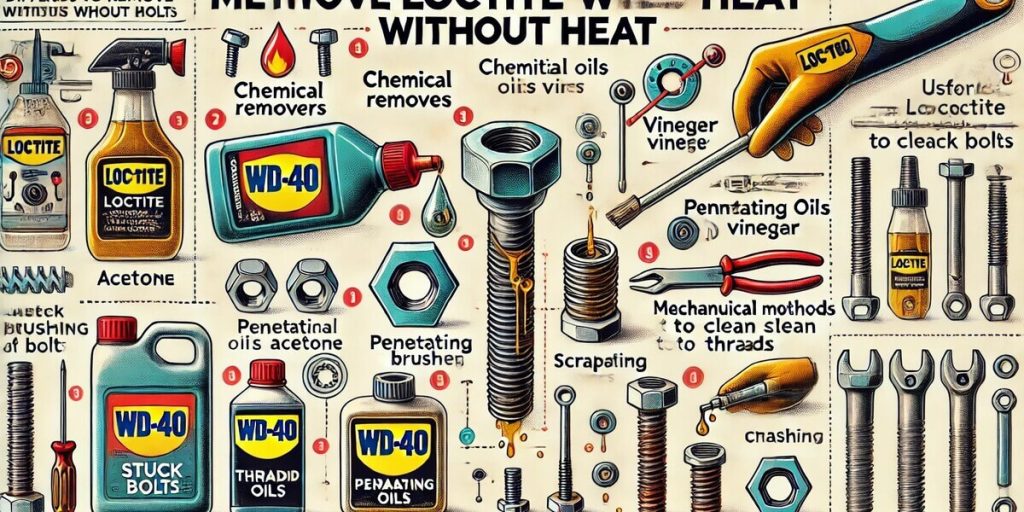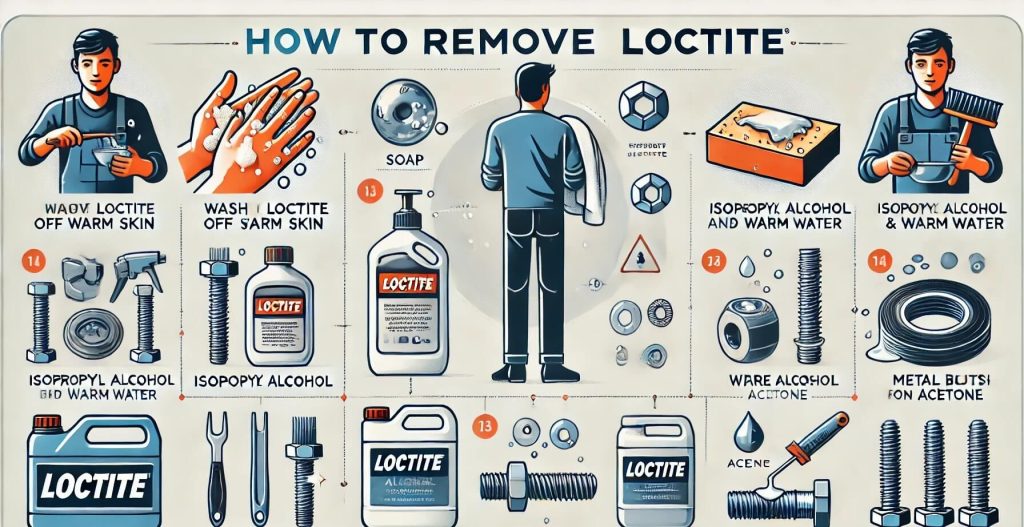Last Updated on February 18, 2025 by Mark S. Taylor
Loctite is a lifesaver when you need bolts to stay put, but when it’s time to take them apart? That’s a different story. I’ve been there—wrench in hand, frustration mounting, wondering how to remove Loctite without stripping threads or breaking tools. Whether you’re dealing with red Loctite, which feels like it’s welded on, or blue Loctite, which is stubborn but manageable, there’s a right way to do it. I’ll walk you through the best methods, from using heat to simple tricks that work without fancy tools. Let’s make this easy—no more stuck bolts!

Contents
How to Remove Loctite Based on Type
Removing Loctite isn’t a one-size-fits-all process—some types need brute force, while others just need the right tool. If you’ve ever fought with a bolt that won’t budge, you know the struggle. Red Loctite? That stuff is practically cemented in place. Blue Loctite? A little easier, but still stubborn when it wants to be. Whether you’re using heat, hand tools, or a mix of both, let’s go step by step so you can break the bond without breaking a sweat.
1. How to Remove Red Loctite (High Strength)
Red Loctite is the heavyweight champion of threadlockers—it’s designed to hold bolts permanently. If you’re trying to remove it with just a wrench, good luck! The trick? Heat. Loctite softens around 500°F (260°C), so applying direct heat with a torch, heat gun, or even a soldering iron can loosen the bond. Once heated, grab an impact wrench or breaker bar to twist it free.
Can you remove red Loctite without heat? Maybe, but it’s tough. Some people use strong solvents or penetrating oils, but heat is the most reliable method.
2. How to Remove Blue Loctite (Medium Strength)
Blue Loctite isn’t as stubborn as red, but it still puts up a fight. The good news? You usually don’t need heat. A solid wrench, ratchet, or pliers should do the trick. If the bolt won’t budge, a little heat can help, but it’s not always necessary.
Struggling with a stuck bolt? Try a longer wrench for extra leverage, or apply penetrating oil and let it sit before attempting removal.
3. How to Remove Loctite from Threads, Bolts, and Metal Parts
If you’ve removed the bolt but still see Loctite stuck in the threads, don’t panic. Here’s how to clean it up:
- Use a wire brush or thread chaser to scrub off residue.
- Soak in acetone or brake cleaner for stubborn Loctite.
- Compressed air can help clear out loosened debris.
Mistakes to avoid? Don’t force a bolt out if it’s not moving—apply heat or oil first. And never reuse a bolt with leftover Loctite unless it’s completely clean!
Now that you know the best ways to remove Loctite, let’s move on to special cases—like how to remove it without heat or from sensitive materials.

How to Remove Loctite Without Heat
Sometimes, heat isn’t an option. Maybe you’re working near plastic parts that could melt, or you just don’t have a heat gun lying around. Don’t worry—you can still break the bond using chemicals, oils, or a little elbow grease. I’ve had to do this myself when dealing with delicate parts, and trust me, it works!
Using Chemical Removers
If you need a quick fix, acetone, nail polish remover, or WD-40 can help soften Loctite. Just soak the area for a few minutes and let the solvent break down the adhesive. For stubborn cases, apply multiple times and scrub gently with a brush.
💡 Quick Tip: Acetone works best on fresh Loctite, but for stronger bonds, try commercial threadlocker removers.
Using Penetrating Oils
When a bolt feels completely stuck, penetrating oils like PB Blaster, Liquid Wrench, or WD-40 can work wonders. Spray it on, wait 10-15 minutes, and let the oil seep into the threads. Then, grab your wrench and try again—it should turn much easier!
Mechanical Methods
If chemicals don’t do the trick, go old-school with manual tools. Use a wire brush, scraper, or thread chaser to physically remove Loctite from bolts and threads. For deep-set residue, a tap and die set can help restore threads without damaging them.
🛠️ Pro Tip: Avoid excessive force—damaging the threads can make removal even harder. Instead, work in small steps and reapply chemicals if needed.

How to Remove Loctite from Different Surfaces
Loctite works great on bolts, but what happens when it ends up on your skin, plastic, or clothes? I’ve had my fair share of accidental spills, and trust me—it’s not fun. But don’t panic! Whether it’s stuck to your hands, melted onto plastic, or hardened on your favorite shirt, there’s a way to clean it up without damage.
1. How to Remove Loctite from Skin
If you’ve ever gotten Loctite on your fingers, you know it dries fast and leaves a stubborn residue. The trick? Soapy water and oil. Wash your hands with warm, soapy water first. If that doesn’t work, rub some olive oil, coconut oil, or petroleum jelly on the area to loosen the adhesive. Gently scrub with a soft cloth until it peels away.
⚠️ When to seek medical help: If Loctite gets in your eyes or mouth, don’t try DIY solutions—seek medical attention immediately.
2. How to Remove Loctite from Plastic
Unlike metal, plastic can warp or melt with heat, so you’ll need a gentler approach. Avoid strong solvents like acetone—they can damage plastic surfaces. Instead, use isopropyl alcohol or mild soapy water. Apply with a soft cloth, let it sit for a few minutes, then wipe away. For stubborn spots, gently scrape with a plastic card (like an old credit card).
🔍 Pro Tip: If you’re unsure how a solvent will react, test it on a hidden part of the plastic first.
3. How to Remove Loctite from Hands and Clothing
Got Loctite on your clothes? Act fast! First, let it dry completely—trying to wipe wet Loctite can spread the stain. Once dry, scrape off as much as possible with a blunt knife. Then, apply rubbing alcohol or vinegar to break down the adhesive. Gently blot (don’t rub!) with a cloth until it lifts.
🚫 What to avoid: Never use hot water—it can make Loctite bond even stronger to fabric.
Best Loctite Removers: Chemicals and Tools That Work
Loctite is great for keeping bolts tight, but when you need to remove it, you need the right solution. I’ve been there—turning a wrench with all my strength, only to realize I needed something stronger than muscle. Whether you’re dealing with red Loctite, blue Loctite, or even super glue, here are the best ways to break the bond without frustration.
Recommended Commercial Products
If you want something that works fast, try a commercial Loctite remover. Loctite SF 790 is made for this job—it softens the adhesive so it wipes right off. Another great option is Permatex Gasket Remover, which works well on stubborn red Loctite.
🛠️ Tip: These removers have strong fumes, so use them in a well-ventilated area.
DIY Alternatives That Work
No commercial remover? No problem. Vinegar, rubbing alcohol, or brake cleaner can help loosen Loctite. Just soak a rag, press it on the area, and wait a few minutes before wiping it away.
💡 Quick Fix: Rubbing alcohol works best for blue Loctite, while brake cleaner tackles red Loctite more effectively.
How to undo red Loctite without heat?
Red Loctite is strong, but soaking it in a commercial remover like Loctite SF 790 or acetone can help weaken the bond. Penetrating oils like WD-40 may also work with patience.
What is the best way to remove Loctite from threads?
Use a wire brush, acetone, or a thread chaser to clean Loctite from threads. If residue remains, soak in a Loctite remover or brake cleaner, then scrub gently.
Can WD-40 remove Loctite?
Yes, WD-40 can help loosen Loctite, especially blue Loctite. Spray it on, wait 10–15 minutes, then try removing the bolt. It works best when combined with manual force.
Is acetone safe to use on metal for Loctite removal?
Yes, acetone is safe for metal and works well to dissolve Loctite. Apply it with a cloth, let it sit, then wipe away the loosened adhesive. Avoid using on painted surfaces.
How do I remove Loctite super glue from surfaces?
For smooth surfaces, use acetone or nail polish remover to dissolve the glue. On delicate surfaces, try rubbing alcohol or warm, soapy water, then gently scrape.
Can I use vinegar to dissolve Loctite?
Vinegar can help break down Loctite, but it’s less effective than acetone or WD-40. Soak the area in vinegar for 15–30 minutes, then scrub with a brush or cloth.
My Final Thoughts on How to Remove Loctite
If you’ve ever struggled with removing Loctite, you’re not alone. I’ve been there, gripping a wrench, wondering if the bolt would ever move. The key is using the right method—heat for red Loctite, hand tools for blue, and solvents when heat isn’t an option. With patience and the right approach, you can break the bond without damage. Tried a method that worked for you? Share your experience in the comments! Let’s make Loctite removal easier for everyone.
